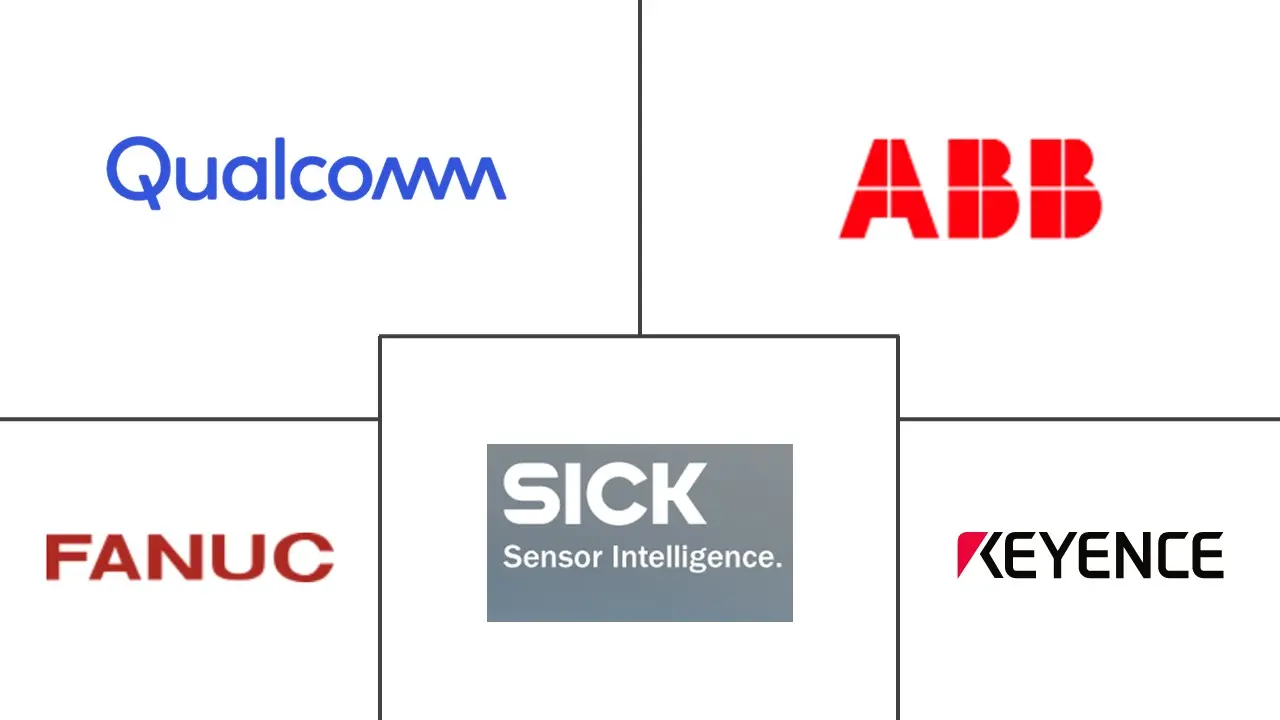Robotic Vision Market Size and Share
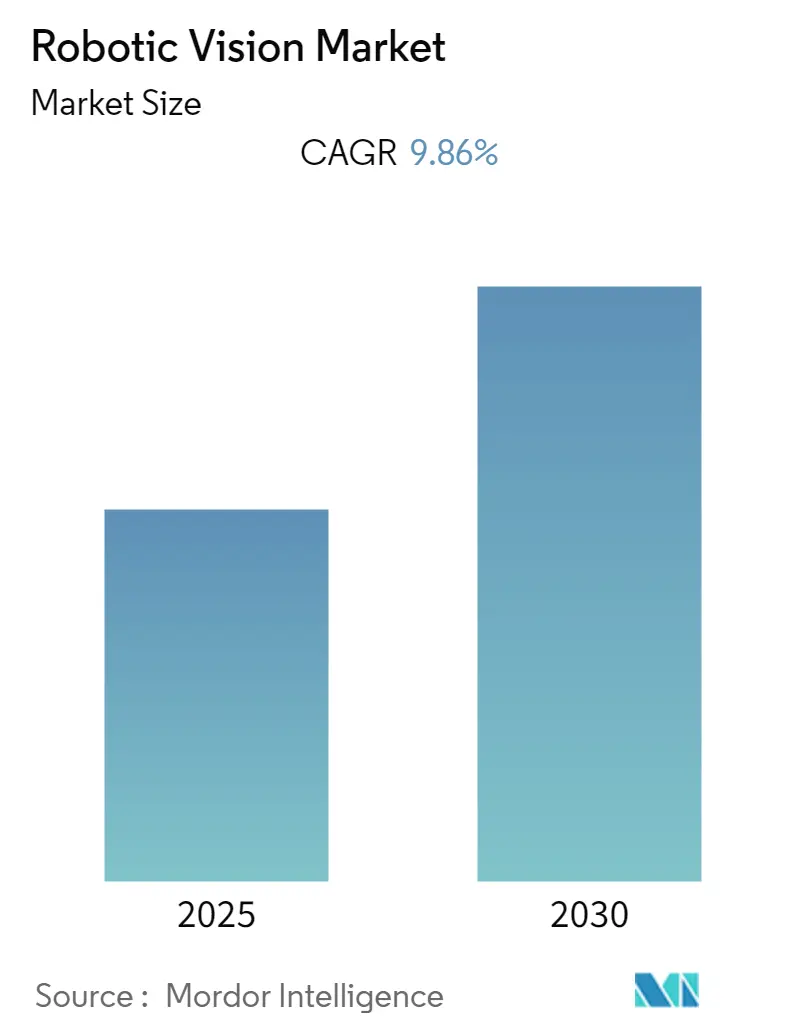
Robotic Vision Market Analysis by Mordor Intelligence
The Robotic Vision Market is expected to register a CAGR of 9.86% during the forecast period.
- Machine guidance systems use 2D and 3D machine vision systems to improve the accuracy and speed of assembly robots and automated material handling equipment, which plays a crucial role in the engine chassis marriage operations. Although the applications vary depending on the vehicle or model being produced, the general categories of applications are observed in robotics, dimensional gaging functions, assembly verification, flaw detection, paint job verification, and code reading.
- Robotic vision provides the robots with a sight that helps them to complement or replace manual inspection tasks using cameras and image processing. The applications range from basic tasks, like presence detection, to real-time inspection.
- Manufacturing companies across the globe realize the benefits of these robotic vision systems, particularly in areas where redundant tasks, like inspection, should be performed with precision. They play an essential role in high-speed production lines and hazardous environments. These systems' significant benefits include increased productivity, reduced machine downtime, and tighter process control.
- Significant expenditures are required to develop the core components of robotic vision, such as vision sensors and the underlying vision software. The initial cost of implementing robotic vision is also slightly more significant, which may impede market expansion.
- The COVID-19 pandemic is expected to increase the growth of vision-guided robots that can reduce human contact in multiple end-user industries. For instance, Orrbec, a US-based company, collaborated with robot manufacturers in China to deploy its 3D camera products in robots for different hospital applications. Food delivery robots, sterilization robots, and directional guiding robots using machine vision systems have been deployed across many hospitals in China. With the increased adoption of cognitive humanoid robots, the market is proliferating after the pandemic.
Global Robotic Vision Market Trends and Insights
Growing Demand from End-User Segments like Automotive Industry Drives the Market Growth
- To address quality issues, Automotive manufacturers are increasingly investing in vision systems. The technology is increasingly being used by automakers and parts suppliers for various applications, including adhesive dispensing, bin picking, error-proofing, inline welding analysis, material handling, robotic guidance, surface inspection, and traceability. Growing demand for customization, increasing labor shortages, and cost pressures are some significant drivers of vision systems used in the auto industry.
- Vision-guided robots are projected to revolutionize the electronics, automotive, and food processing industries. Due to the tremendous technology demand for applications such as arc welding, cutting, and palletizing, these industries are dominated by 3D vision-guided technology.
- Advanced machine vision technology plays a significant role in the daily operation of various global automotive plants. Ford Motor Co.'s Van Dyke transmission plant, for instance, uses vision-guided robots to ensure the high-quality assembly of critical components like gears and clutches. The plant has deployed over 500 inline machine vision applications for error-proofing, gauging, and complexity issues.
- With the growth of the ADAS system in Automotives, the requirement of components like camera-led lighting, Lidar, and V2X, among others, would play a crucial role shortly for automation and intelligence. Further, according to Neuromation, traffic accidents account for 2.2% of global deaths. With 2D and 3D machine vision and intelligent transportation systems (ITS), drivers are provided with a safety net. These technologies make it possible to mitigate human error in the auto industry, assisting drivers at the wheel with tools and features that keep them from committing severe mistakes and accidents.
- Because of their noncontact inspection, high repeatability, and minimal cost, robotic vision systems are becoming more popular for quality control in various sectors. Traditional methods of product quality control rely entirely on human inspection. On the other hand, human inspection performance is projected to decline over a shift of work owing to weariness and repetition. Minor faults may go unnoticed, resulting in non-trivial errors. Technological breakthroughs are transferring the time-consuming inspection labor from humans to machine automation. Significant advances in hardware and software have already shifted most of the quality control inspection labor to machines in various regions of the globe. According to IFR, With approximately 168 thousand new industrial robot installations in China, it had set up the most robotics-worldwide in the previous year.
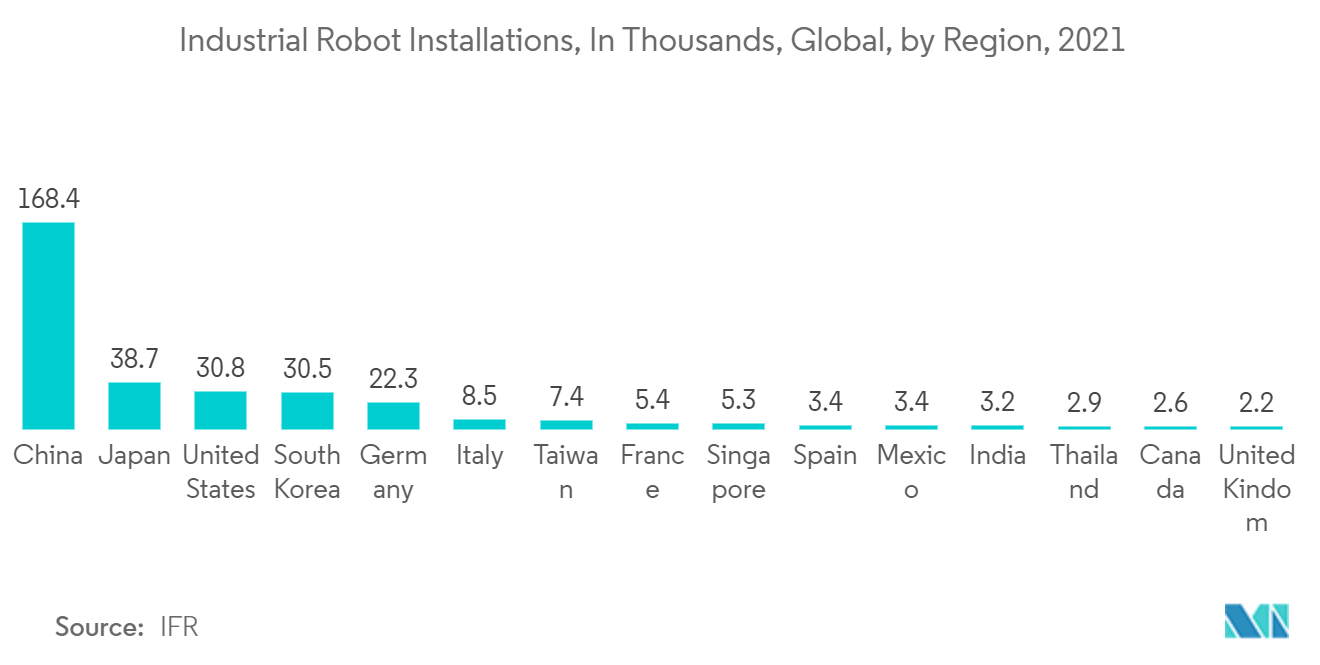
North America is Expected to become the Fastest Growing Market
- In robotics adoption, North America is one of the significant inventors and pioneers and one of the world's largest markets. The rising deployment of robotics across various sectors is the key driver of the market's growth.
- According to the International Federation of Robotics, North American industrial robot deployments are predicted to reach 69,000 annually by the current year. According to Advancing Automation, the number of robots sold last year was estimated to rise by 28% over before previous year. As more sectors resorted to automation to enhance productivity and reduce persistent labor shortages, record robot sales were recorded in the fourth quarter of the last year (up by 9% from the fourth quarter of before earlier year), demonstrating strong momentum already gained in the previous few months.
- Industrial robots are critical in industrial automation, with various robots managing many vital functions in multiple industries. Electronics, e-commerce, and automotive industries, among others, are growing in tandem with economic expansion in many countries in this region. Product manufacturers are rapidly employing robots to automate repetitive procedures in response to rising demand across economies.
- Machine vision systems would be produced more frequently due to government efforts such as the Advanced Manufacturing Partnership, which aims to encourage businesses, universities, and the federal government to invest in future automation technology.
- According to the MAPI (Manufacturers Alliance for Productivity and Innovation), industrial production in the United States was estimated to rise by 2.8% by the earlier year, boosting the country's use of robotic vision technologies.
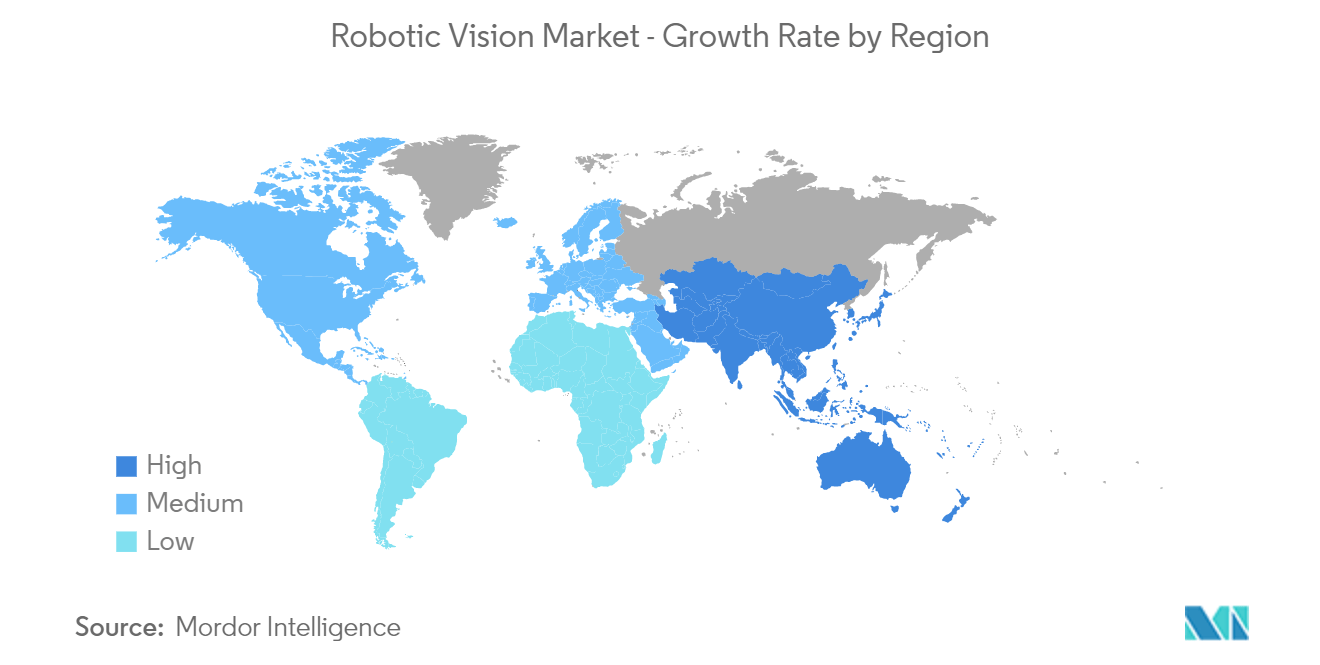
Competitive Landscape
The robotic vision market is moderately fragmented due to major players like Qualcomm Technologies, Inc., Keyence Corporation, FANUC Corporation, ABB Group, and Sick AG. Players in the market are adopting strategies such as partnerships, innovations, and acquisitions to enhance their product offerings and gain sustainable competitive advantage.
- October 2022 - ABB announced a strategic partnership with the US-based startup Scalable Robotics to expand its user-friendly robotic welding solutions line. Scalable Robotics technology, which uses 3D vision and embedded process awareness, enables users to program welding robots without coding.
Robotic Vision Industry Leaders
-
Qualcomm Technologies, Inc.
-
Keyence Corporation
-
FANUC Corporation
-
ABB Group
-
Sick AG
- *Disclaimer: Major Players sorted in no particular order
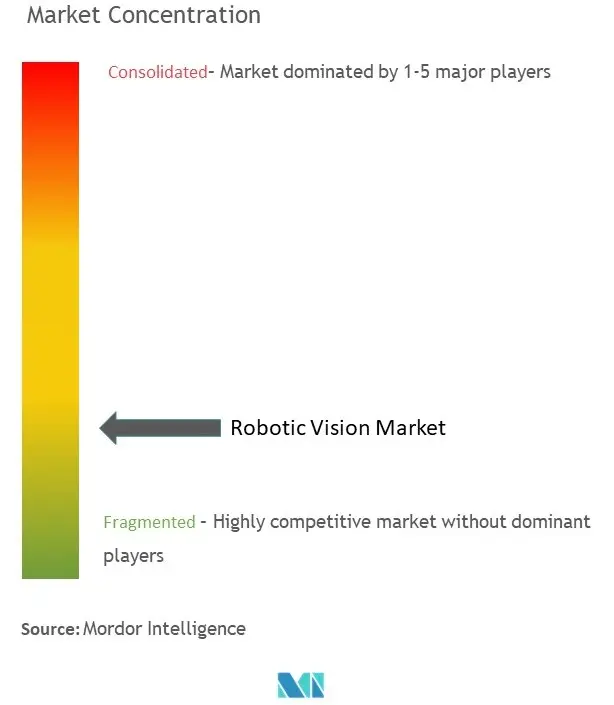
Recent Industry Developments
- September 2022 - Following the 2021 acquisition of mobile robot company ASTI Mobile Robotics, ABB has launched its first line of branded Autonomous Mobile Robots (AMRs). ABB has a fully integrated offering of robots, AMRs, and machine automation solutions. ABB, which already provides AMR solutions for client projects, has collaborated with crucial partner Expert Technology Group in the UK to develop a complete assembly line based on AMRs for a technology startup creating breakthrough parts for EV vehicle drive trains. ABB's automation system uses ABB robots, vision function packages, and AMRs to transport products between robotic automation cells and human assembly stations.
- August 2022 - Visionary.ai, a software-based image signal processor (ISP) technology developer, and Innoviz, one of the providers of high-performance, automotive-grade LiDAR sensors, and perception software, announced a new partnership to combine Visionary.ai's imaging technology with Innoviz's LiDAR sensors and perception software. The two technologies, when Combined, offer to improve 3D machine vision performance for a variety of applications, including robots and drones.
Global Robotic Vision Market Report Scope
Robotic Vision is a technology that combines vision algorithms and cameras to equip robots with vision-like capabilities. Various technologies are available, each tailored to a specific use. Robotic Vision enables the robot to execute both simple and complex tasks. Robotic Vision is one of the most recent advancements in robotics and automation. In essence, robot vision is a sophisticated technology that aids a robot, usually an automated robot, in better-recognizing things, navigating, finding objects, inspecting, and handling parts or bits before performing an application.
The report provides detailed market numbers and trends in the robotic vision market. The market has been segmented into end-user industries such as automotive, electronics, aerospace, food and beverage, pharmaceutical, and other end-user industries. The market is also segmented by technology, and additionally, the report provides the robotic vision trends in different regions, along with crucial vendor profiles. The study also covers the impact of COVID-19 on the market studied.
The Robotic Vision Market is segmented by Technology (2D Vision, 3D Vision), by End - User Industry (Automotive, Electronics, Aerospace, Food & Beverage, Pharmaceutical), and Geography (North America, Europe, Asia Pacific, Latin America, Middle East, and Africa). The market sizes and forecasts are provided in terms of value in USD million for all the above segments.
| 2D Vision |
| 3D Vision |
| Automotive |
| Electronics |
| Aerospace |
| Food and Beverage |
| Pharmaceutical |
| Other End User Industries |
| North America |
| Europe |
| Asia Pacific |
| Rest of the World |
| By Technology | 2D Vision |
| 3D Vision | |
| By End User Industry | Automotive |
| Electronics | |
| Aerospace | |
| Food and Beverage | |
| Pharmaceutical | |
| Other End User Industries | |
| Geography | North America |
| Europe | |
| Asia Pacific | |
| Rest of the World |
Key Questions Answered in the Report
What is the current Robotic Vision Market size?
The Robotic Vision Market is projected to register a CAGR of 9.86% during the forecast period (2025-2030)
Who are the key players in Robotic Vision Market?
Qualcomm Technologies, Inc., Keyence Corporation, FANUC Corporation, ABB Group and Sick AG are the major companies operating in the Robotic Vision Market.
Which is the fastest growing region in Robotic Vision Market?
Asia Pacific is estimated to grow at the highest CAGR over the forecast period (2025-2030).
Which region has the biggest share in Robotic Vision Market?
In 2025, the North America accounts for the largest market share in Robotic Vision Market.
What years does this Robotic Vision Market cover?
The report covers the Robotic Vision Market historical market size for years: 2019, 2020, 2021, 2022, 2023 and 2024. The report also forecasts the Robotic Vision Market size for years: 2025, 2026, 2027, 2028, 2029 and 2030.
Page last updated on:
Robotic Vision Market Report
Statistics for the 2025 Robotic Vision market share, size and revenue growth rate, created by Mordor Intelligence™ Industry Reports. Robotic Vision analysis includes a market forecast outlook for 2025 to 2030 and historical overview. Get a sample of this industry analysis as a free report PDF download.
